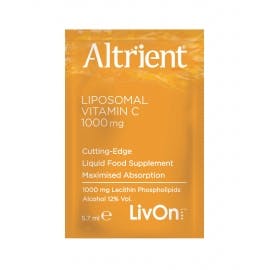The 6 Important Roles of Vitamin C
Aside from its ability to prevent scurvy, vitamin C is also required in many essential metabolic processes. A few of the highly studied physiological functions are discussed below.
1. Collagen Synthesis
Vitamin C is essential for the synthesis and maintenance of collagen, the most abundant protein in the human body. Collagen comprises about 25% to 35% of the total protein content in the body. Its strong, connective, elongated fibrils are found in skin, ligaments, tendons, cartilage, bone, blood vessels, the intestines, and the discs between spinal vertebrae. It is also found in the cornea and in muscle tissue.
Important research relating vitamin C to collagen has shown:
Vitamin C helps protect the skin by promoting the production and migration of fibroblasts that support normal wound healing.
Vitamin C protects against skin wrinkles seen in premature aging.
Increased vitamin C uptake by vascular smooth muscle cells increases the synthesis and maturation of Type I (aka Type 1) collagen. Type I collagen accounts for about 90% of the body’s total collagen content.
High concentrations of vitamin C stimulate synthesis of Type IV collagen, which has important filtration characteristics in the kidney, the blood-brain barrier, and the arterial lining .
2. Basement Membrane Synthesis
Basement membrane is a thin, sticky layer that supports epithelial cell layers — tissues that line the surfaces and cavities throughout the body (like the lining of the stomach and the lining of blood vessels). It binds the glomerular capillaries in the kidneys to the Bowman’s capsule which is necessary for blood filtration. It also attaches the pulmonary capillaries in the lungs to the lung alveoli. In addition, basement membrane functions as a restrictive barrier to prevent cancer cells from passing deeper into tissues.
Vitamin C is related to the basement membrane in the following ways:
Vitamin C maintains the gel-like state of the basement membrane, helping to suppress tumor invasion through the basement membrane.
Vitamin C deficiency reduces the release of basement membrane components (Type IV collagen, laminin, elastin) in blood vessels.
Vitamin C accelerates the deposition of other important basement membrane proteins in the area between the dermis and epidermis.
3. Carnitine Synthesis
Vitamin C is an essential cofactor for the synthesis of carnitine - an amino acid that is necessary for the transport of fatty acids into mitochondria. This transfer of fatty acids is an important factor in the production of the ATP that is necessary for cellular energy.
4. Neurotransmitter Synthesis
Vitamin C is directly involved in the synthesis of neurotransmitters. Neurotransmitters are biological molecules that facilitate the electrical flow between neurons and nerve cells in the body and in the brain. The body’s ability to respond to the environment, as well as the brain’s ability to think and to remember, is dependent on these essential substances.
5. Promotes Calcium Incorporation into Bone Tissue
The formation and maintenance of quality, high-density bone material requires vitamin C. Vitamin C promotes assimilation of calcium into the bone, protects against leaching of calcium out of the bones, and fights the oxidative stress that works against assimilation.
Additional relationships between vitamin C and bone metabolism include the following:
Vitamin C stimulates the formation of the cells that incorporate calcium into bone tissue (osteoblasts).
Vitamin C inhibits the development of cells that dissolve calcium out of bone tissues (osteoclasts).
As a powerful antioxidant, vitamin C fights oxidative stress in bone tissues.
Collagen cross-linking, required to form the dense matrix for optimal bone strength, requires vitamin C.
6. Immune System Function and Maintenance
The immune system functions of vitamin C are so important that they are discussed in greater detail in [link to] 20 Ways Vitamin C Supports a Healthy Immune System.
Here is a quick list of how vitamin C works with the immune system:
Vitamin C supports:
Production of interferons
Function of phagocytes
Cytokine production by white blood cells
Cell-mediated immune response
Nitric oxide production by phagocytes
T-lymphocyte proliferation
B-lymphocyte proliferation
Antibody production and complement activity
Natural killer cell activity
Prostaglandin formation
Cyclic GMP levels in lymphocytes
Localized generation of, and/or interaction with, hydrogen peroxide
Detoxification of histamine
Neutralization of oxidative stress
Immune response to vaccination
Mucolytic effect
Function of antibiotics
Vitamin C inhibits:
Various forms of T-lymphocyte death
Neuraminidase production
References
Duarte TL, Cooke MS, Jones GD, “Gene expression profiling reveals new protective roles for vitamin C in human skin cells” Free Radic Biol Med 2009 Jan 1 46(1):78-87.
Hashem MA, et al, “A rapid and sensitive screening system for human type I collagen with the aim of discovering potent anti-aging or anti-fibrotic compounds” Mol Cells 2008 Dec 31 26(6):625-30.
Qiao H, et al, “Ascorbic acid uptake and regulation of type I collagen synthesis in cultured vascular smooth muscle cells” J Vasc Res 2009 46(1):15-24.
Boyera N, Galey I, Bernard BA, “Effect of vitamin C and its derivatives on collagen synthesis and cross-linking by normal human fibroblasts” Int J Cosmet Sci 1998 Jun 20(3):151-8.
May JM, Qu ZC, “Transport and intracellular accumulation of vitamin C in endothelial cells: relevance to collagen synthesis” Arch Biochem Biophys 2005 Feb 1 434(1):178-86.
Saitoh Y, Nagai Y, Miwa N, “Fucoidan-Vitamin C complex suppresses tumor invasion through the basement membrane, with scarce injuries to normal or tumor cells, via decreases in oxidative stress and matrix metalloproteinases” Int J Oncol 2009 Nov 35(5):1183-9.
Mahmoodian F, Peterkofsky B, “Vitamin C deficiency in guinea pigs differentially affects the expression of type IV collagen, laminin, and elastin in blood vessels” J Nutr 1999 Jan 129(1):83-91.
Marionnet C, et al, “Morphogenesis of dermal-epidermal junction in a model of reconstructed skin: beneficial effects of vitamin C“ Exp Dermatol 2006 Aug 15(8):625-33.
Rebouche CJ, “Ascorbic acid and carnitine biosynthesis” Am J Clin Nutr 1991 Dec 54(6 Suppl):1147S-1152S.
Naidu KA, “Vitamin C in human health and disease is still a mystery? An overview” Nutr J 2003 Aug 21 2:7.
Gabbay KH, et al, “Ascorbate synthesis pathway: dual role of ascorbate in bone homeostasis” J Biol Chem 2010 Jun 18 285(25):19510-20.
Yalin S, et al, “Is there a role of free oxygen radicals in primary male osteoporosis?” Clin Exp Rheumatol 2005 Sep-Oct 23(5):689-92.
Park JB, “The Effects of Dexamethasone, Ascorbic Acid, and β-Glycerophosphate on Osteoblastic Differentiation by Regulating Estrogen Receptor and Osteopontin Expression” J Surg Res 2010 Oct 8.
Hie M, Tsukamoto I, “Vitamin C-deficiency stimulates osteoclastogenesis with an increase in RANK expression” J Nutr Biochem 2011 Feb 22(2):164-71.
Sheweita SA, Khoshhal KI, “Calcium metabolism and oxidative stress in bone fractures: role of antioxidants” Curr Drug Metab 2007 Jun 8(5):519-25.
Saito M, “Nutrition and bone health. Roles of vitamin C and vitamin B as regulators of bone mass and quality” Clin Calcium 2009 Aug 19(8):1192-9.
Maehata Y, et al, “Type III collagen is essential for growth acceleration of human osteoblastic cells by ascorbic acid 2-phosphate, a long-acting vitamin C derivative” Matrix Biol 2007 Jun 26(5):371-81.
Pasco JA, et al, “Antioxidant vitamin supplements and markers of bone turnover in a community sample of nonsmoking women” J Womens Health (Larchmt) 2006 Apr 15(3):295-300.
Sugiura M, et al, “Dietary patterns of antioxidant vitamin and carotenoid intake associated with bone mineral density: findings from post-menopausal Japanese female subjects” Osteoporos Int 2011 Jan 22(1):143-52
Ruiz-Ramos M, et al, “Supplementation of ascorbic acid and alpha-tocopherol is useful to preventing bone loss linked to oxidative stress in elderly” J Nutr Health Aging 2010 Jun 14(6):467-72.
Zinnuroglu M, et al, “Prospective evaluation of free radicals and antioxidant activity following 6-month risedronate treatment in patients with postmenopausal osteoporosis” Rheumatol Int 2011 Jan 8.
© 2014 LivOn Labs. Content adapted from Primal Panacea by Thomas E. Levy, MD, JD.


.jpg?auto=format&q=45&w=262&trim=auto)
.jpg?auto=format&q=45&w=262&trim=auto)
